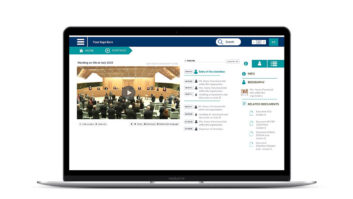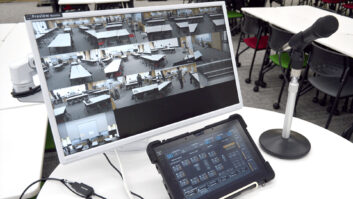Containment policy
Feb 1, 1999 12:00 PM,
Toni Flosi
Landmarks abound throughout the greater Los Angeles area, but to the sportsfanatic, none carries the fame or history of the venerable Rose BowlStadium, a 76-year-old monument to athletic excellence. For all theprestige the Rose Bowl Stadium offers the city of Pasadena, however, manyof its nearby neighbors voiced dismay at the noise that spilled over fromthe stadium’s walls. With a backdrop created by the 9,000 foot (2,743 m)San Gabriel Mountains, the areas surrounding the stadium are dotted withelegant hotels, attractive homes and beautiful gardens in bloom year-round.Imagine having this idyllic paradise regularly disturbed by stadium noise.With a capacity for more than 100,000 fans, the Rose Bowl’s famouselliptical shape is a well-known sight to millions of households worldwide.After all, what would New Year’s Day be without the Rose Bowl game? Thereare also other events that keep the stadium in use. Besides hosting fiveNFL Super Bowls, the World Cup championship game in 1994, UCLA football,Major League Soccer, Fourth of July Celebrations, concerts, religiousservices and the world’s largest flea market, the stadium is heavily rentedfor concerts and film location shooting.
With all this going on, there is rarely a quiet weekend. The stadium’s12-year-old sound system bled outside the stadium walls and into adjacentneighborhoods, disrupting life for many of the city’s 139,000 residents.The existing point-source cluster of loudspeakers, although once adequate,became a problem when a new press box and luxury suites were added. Theseadditional structures created surfaces of reflection, thereby exaggeratingthe already difficult neighborhood-relations problem. A new sound systemwas clearly necessary, but finding the proper system proved to be the realchallenge.
The Rose Bowl Operating Company, managers of the city-owned stadium, hiredacoustical consultants Vene-klasen & Associates, Santa Monica, CA, todesign a new sound system. Vene-klasen & Associates teamed up with soundinstaller Daryl Ballou of Musi-Cal, Riverside, CA, to find the mosteffective means of confining high-volume sound inside the stadium. Ballouused JBL’s CADP2 modeling software to determine the direct and reflectedsound generated from different system designs and then determined therequired aiming angles and dispersion patterns required to cover theaudience areas of the stadium. The tough part was finding a loudspeakerthat eliminated the audible spillover problem in the surroundingneighborhoods. Eventually, both Musi-Cal and Veneklasen determined that adistributed system that fired downward toward the field area from atop thestadium’s upper rim was the best possible location. Any other locationwould disturb the unimpeded sightlines that Rose Bowl patrons now enjoy.Now that all the particulars werein place, attention turned to finding theright loudspeaker system.
A series of A/B tests were held within the stadium to determine theloudspeaker system offering the best directionality, pattern control,coverage and sonic capabilities for this specific application.Additionally, the loudspeakers’ weather-resistance would also play adeciding role in the selection. After extensive testing under a range ofoperating conditions, a sound system incorporating Community ProfessionalLoudspeakers’ R2 Series and their new WET Series loudspeakers was chosen.Once the sound design team was awarded the job, they had only 60 days tofinish the design and have the system up and running by the afternoon ofSeptember 12, opening day of the UCLA football season.
Ballou said, “I was familiar with the R2s and knew they’d be perfect forthe Rose Bowl. Once we demonstrated their capabilities, the job was ours”.
Because there was no place to hang a distributed system around the stadium,Ballou and his team decided to mount the loudspeakers atop poles along thestadium’s outer rim. Unfortunately, the Rose Bowl’s existing flag poleswere not strong enough to withstand a wind load of approximately 18,000 lbs(8,100 kg) and hold one R2-52 and two WET 915 loudspeakers. So, the teamcustom-fabricated a series of 22 poles and four mounting systems on top ofthe press box upon which to mount the loudspeakers. The poles are 5 in2 (32cm2), made of 1/4 inch (6.4 mm) tubing and rise 32 feet (9.8 m) into theair, and the attachments for the poles are affixed to an existing concretebeam beneath the concrete seats.
Attaching the poles and loudspeakers was no small task. The team employed a110 foot (34 m) boom lift to position each loudspeaker array atop thepoles. The good news is that the mounting hardware on both the R2s and theWET 915s had been designed to facilitate smooth installation in a range ofapplications.
Ballou said, “Installers will love the easy installation of both the R2 andthe WET series. The mounting hardware cuts down time and headaches.”
Next, 22 R2s were placed on the weight-tested and fabricated poles with thehorns firing downward toward the first row of the stadium seating. To coverthe near field directly under the poles, Ballou used two 44 WET 915 two-wayloudspeakers aimed 50 feet (15 m) out and splayed left and right, and 12R2s were used on top of the press box. Two groups of four R2s arepositioned close to the press box with two R2s flanking the outer edges.These units are pointed downward and splayed left to right.
A TEF12 measuring system was used to determine the delay times for the mainfield loudspeakers on the rim of the stadium to the loudspeakers placed ontop of the press box. Rounding out the Rose Bowl Stadium’s new sound systemare 17 Crown Com-Tech 1610s (powering the R2s) and six Crown Com-Tech 810s(powering the WET Series). The Com-Tech 10 amps are improved versions ofthe reliable Com-Tech line. With separate high-voltage power supplies foreach channel, this series allows sound contractors to run one channel for70 V and the other to drive a 4 V or 8 V load.
“With the loudspeakers about 50 feet apart (15 m) and cable runs greaterthan 2,000 feet (610 m), the Crown Com-Tech 10 Series was our first andonly choice for amp reliability,” Ballou said.
Because of the long cable lengths in the Rose Bowl, Musi-Cal installed acompletely new conduit system with custom-made Edcor transformers todistribute audio signals throughout the stadium.
“It just made sense to use a 70 V system,” said Ballou.
The Edcor 750 W transformers were wound for each R2 loudspeaker for the farthrow, and a 200 W transformer handled the pair of WET loudspeakers on eachpole. All transformers are housed in Hoffman water-tight boxes at each poleposition. Each R2 runs directly to a dedicated channel on the Crown 1610s,and four of the WET loudspeakers share a channel on the Crown 810s. Allconnections were made through 2 inch (51 mm) and 3 inch (76 mm) conduitrunning along the stadium’s rim. The system’s cabling is compatible withthe Crown IQ system, which may be added at a future date.
Included in the front end system are a Klark Teknik 30-band stereo EQ tomake instant level and tonal changes to the loudspeakers, a dbx 266 limiterand five Shure DFR11EQ programmable EQs to cover the stadium’s five audiozones. The zoned design allows the sound crew to turn off areas of thestadium not needing audio.
The recently-introduced Shure DFR11EQ is a cost-efficient digital feedbackreducer and PC-controlled EQ that uses a Windows-based system to identifyfeedback in an audio signal. If feedback is detected, the EQ automaticallyinserts notch filters into the audio path to reduce the gain at thosefrequencies feeding back. These precision notch filters are only 1/10octave wide and set at a depth of 3 dB. This filter depth automaticallyincreases in 3 dB increments until the feedback is eliminated. The DFR11EQhas a total of 10 adaptive notch filters per zone and can function aseither a 30-band graphic EQ or a 10-band parametric EQ, which allows theuser to set a filter with an adjustable frequency, depth and bandwidth. Amaximum 16 units can be linked and controlled by a single PC.
In addition, the stadium system employs a Symetrix limiter and an Intellix8002 mixer to inject an emergency mic from the security office into thepublic address system. A VIP 110 voice processor is also available as aninsert in the FOH mixer if necessary. Three-quarters of the amp reside in adesignated equipment room on the stadium’s east side. The remainingcomponents are situated in a room above the new press box.
On September 12th, the audio system had its first big test as the UCLABruins kicked off their 1998-1999 season against the University of TexasLonghorns in front of 80,000 screaming fans.
Ballou said, “I was on the press elevator with a sound guy from Texasduring the opening game, and he told me that this was the best stadiumaudio he had ever heard.”
Currently, Veneklasen is conducting noise tests throughout the community,but the results seem to have already come in.
“Since the system was installed, the neighbors around the stadium haven’tmade one complaint about the loudspeaker noise,” said Ballou.
What’s more, Ballou said that the vocal reproduction is extremely warm andintelligible, and the music is clean-sounding with surprisingly smoothfrequency response.
“Believe it or not, pink noise variations were +/-2 dB in 99% of theseats,” he said.
Ballou credits the team at Community with not only producing and deliveringthe Rose Bowl’s contingent of R2s in only 30 days, but also with literallycreating the new WET915s in the same time frame.
No complaints from the audio installation team, no complaints from thenoise-sensitive citizens of Pasadena, and a 49 to 31 opening day victoryfor the UCLA Bruins. The future looks promising for the new sound for oneof the country’s most beloved sports stadiums.










